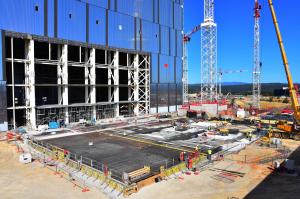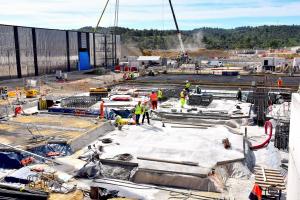Heat waves
25 Jul 2016
A building that is 45 metres long, 49 metres wide and 26 metres high—that is what it will take to host the powerful radiofrequency sources that will contribute their power to heating the ITER plasma.
Located adjacent to the Assembly Hall, the Radiofrequency Heating Building will be home to the 24 ITER gyrotrons that will each generate microwave beams over a thousand times more powerful than a home microwave oven. The building will also host the generators that produce high-power radio frequency waves for the two 45-tonne antennas of the ion cyclotron resonance heating system.
Steel reinforcement work and concrete pouring are underway now on the building's foundation slab. Both systems will be connected to the ITER Tokamak by way of transmission lines and will deliver a total of 40 MW of heating power to the plasma.
Equipment installation is scheduled in late October 2017 and building handover, once all equipment is installed, in August 2018.



